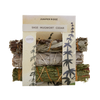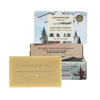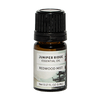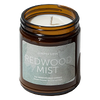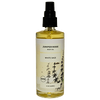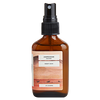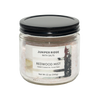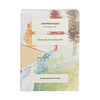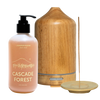
A beautiful product must come from a beautiful process. That artisan mindset guides everything I do at Juniper Ridge. The essential oils, body washes, colognes, and all of the good smells we create are celebrations of the magnificent land we live on. The goods we make come directly from the relationship we have with the glorious landscapes that we’re so lucky to work, live, play, and wander in, and this all starts with the harvest.
We harvest our juniper from the remote hills in the oft-overlooked slice of California known as the Temblor Range. This tranquil ridge of mountains sits between the coastal crags of Big Sur and the wide agricultural expanse of the San Joaquin Valley. The weather that pours over the coast drops most of its precipitation on the Santa Lucia Range above Big Sur, so the Temblors are left dry and spacious, clothed in the oaks and grass of California chaparral. The hardy California Juniper (Juniperus californica) thrives here. This land remains true California cowboy country, and we work with ranchers that are using these hills to range their cattle.

This fall I made my first pilgrimage to juniper country. With a team of five we made our way into those hills, winding up the narrow farm lanes, slowing down once the pavement ended and the road turned to a trail that seemed impossibly narrow for our chipper rig. Pablo, our wildcrafting expert, led us through the maze of unsigned fire roads deep into the heart of the Temblors. He’s been coming to these hills for years to spend time with the juniper, and he knows all of the secrets. We set up camp just as the purple of dusk soaked the rippling hills that stretch into the distance. As the stars came out and the evening breeze died, the timeless feeling of that place settled over us. It’s the sort of landscape that lets you know that you are very small, but also very alive.
The next three days were a blur that stank of sweat and juniper. The actual act of harvesting is simple, but strenuous. We seek out areas where the juniper is growing well and abundantly and where we can access it easily from the trail. We don’t kill the juniper trees we’re harvesting: we trim branches that are in competition with one another, or limbs that have become shaded by other foliage. We cut the juniper so they can stay healthy, thrive, and grow so we can come back year after year to an ecosystem that is balanced and flourishing. We cut with a compassion for the plants and with a care for what they need. Then, by hand, foot, and back we haul all of the cut material to the trail where we chip it into our truck. It’s the hauling that makes us sit heavy and tired around the campfire at the end of the day, and that makes the beer taste so right. Even the perfect display of stars couldn’t keep us awake past nine.



Once our truck was finally full, we rolled up our sleeping bags, packed up the chainsaws, and made our slow way back to our workshop in Oakland. Pablo and I spent the next few days cycling the fragrant chips through our still. Custom built in South Africa, our still is a beautiful contraption that looks like it came directly from a Jules Verne novel. It’s a tangle of hoses, tubes, tanks, and valves, and it’s about the size of a small school bus. When it’s running, the still resonates with a deep calming hum, but the steam rushing through the pipes also makes it sing like a tea kettle. It heats the building and drenches the workshop with the smell of the material being processed. The chips go into a set of great big 500 gallon stainless steel pots, and we pump steam through them for the better part of a day. The heat and pressure of the steam evaporates the most volatile components present in the juniper and pulls them out. Then we cool the mixed vapor down until it condenses back into a liquid blend of water and essential oils. The oils are lighter than water, so once the mixture settles the oil floats to the top and we are able to separate it out. This is the old way of distilling essential oils; the process has changed little for hundreds of years.
The final product is a bottle of thin oil the color of honey with a powerful and complex smell. In that smell is the fresh clean scent of the juniper needles, but also the warmth of the wood. We don’t do anything to steer or direct the scent, we just capture the experience of the juniper trees. Just like the trees, the nature of the oil will change with season, rainfall, and temperature. It’s incomplete. The essential oil does not tell the whole story of the juniper trees that grow in the Temblors, but it does capture a tiny and real slice of that place and all the beautiful processes of those mountains.
Simon Hill, Juniper Ridge Production Manager


